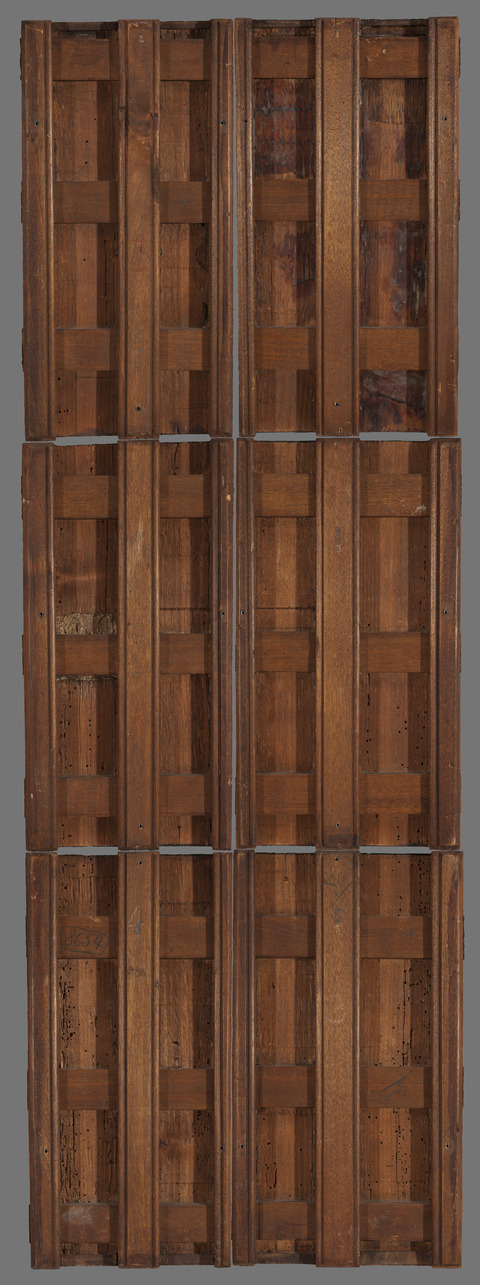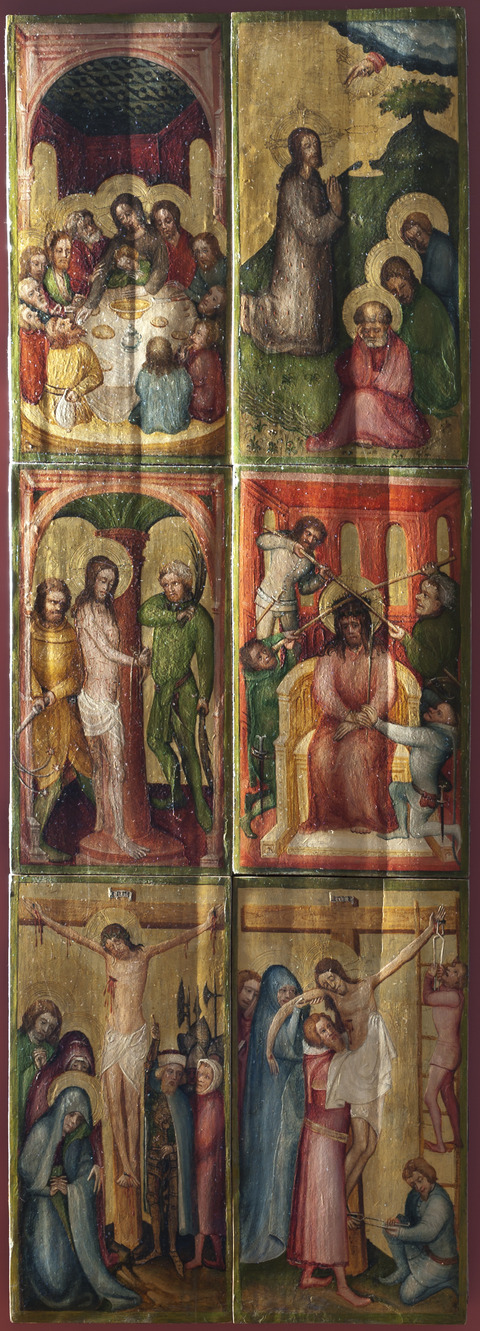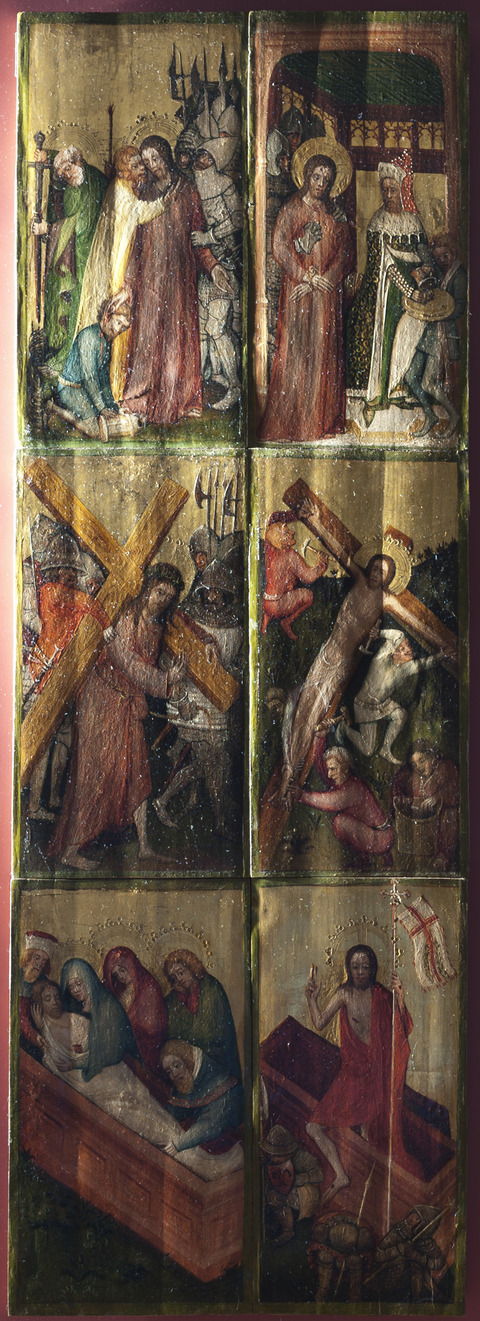Overview
Identification number: 2004.157A-L
Artist: Unknown Artist, South German (or Austrian?)
Title: Passion of Christ
Materials: Egg tempera on fir panel
Date of creation: About 1415–1420
Previous number/accession number: C10002
Dimensions:
| Panel | Title of Panel Scene | Height (cm) | Width (cm) | Thickness with cradle (cm) | Thickness without cradle (cm) |
|---|---|---|---|---|---|
| A | The Last Supper | 37-37.5 | 18.5 | 2.8-3 | 0.6-0.8 |
| B | Agony in the Garden | 37.3-38 | 19.3-19.5 | 2.8-3 | 0.6-0.8 |
| C | Kiss of Judas | 36.5 | 19.3-19.5 | 2.8-3 | 0.6-0.8 |
| D | Pilate Washing His Hands | 36.4-36.6 | 18.3-18.5 | 2.8-3 | 0.6-0.8 |
| E | Christ at the Column | 33.8-34 | 18.4 | 2.8-3 | 0.6-0.8 |
| F | The Mocking of Christ | 33.7-33.8 | 19.6 | 2.8-3 | 0.6-0.8 |
| G | Christ Carrying the Cross | 35.9 | 19.6-19.9 | 2.8-3 | 0.6-0.8 |
| H | Christ Nailed to the Cross | 35.5-36 | 18.4 | 2.8-3 | 0.6-0.8 |
| I | Crucifixion | 36.6-36.8 | 18.4 | 2.8-3 | 0.6-0.8 |
| J | Descent from the Cross | 36.5 | 19.2-19.5 | 2.8-3 | 0.6-0.8 |
| K | Entombment | 36.3 | 20-20.5 | 2.8-3 | 0.6-0.8 |
| L | Resurrection | 36.3 | 17.6-18 | 2.8-3 | 0.6-0.8 |
Conservator/examiner: Fiona Beckett with contributions from Roxane Sperber
Examination completed: 2015, revised 2020.
Distinguishing Marks:
Front:
None
Back:
Panels A, B, E, F, I, J are labeled with Roman numerals on the upper portion of each panel. The locations of Roman numerals are circled on technical figure 1 (tech. fig. 1; see items 1, 4, 7, 9, 10, 12). Panels D, C, H, G, L, K are labeled with Arabic numerals on the upper portion of each panel. The locations of Arabic numerals are circled on technical figure 2 (tech. fig. 2; see items 14, 16, 20, 24, 29, 33).
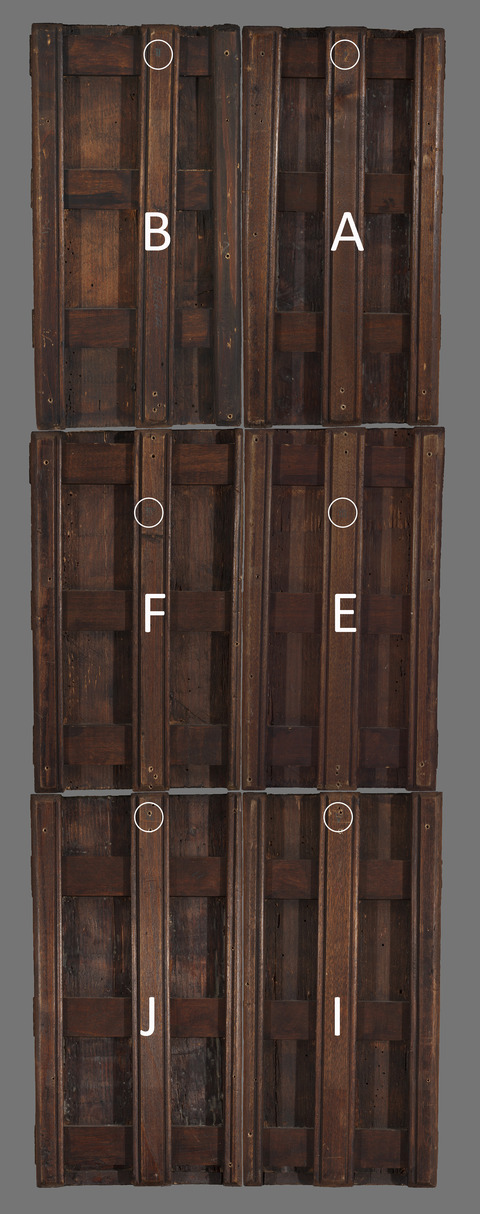
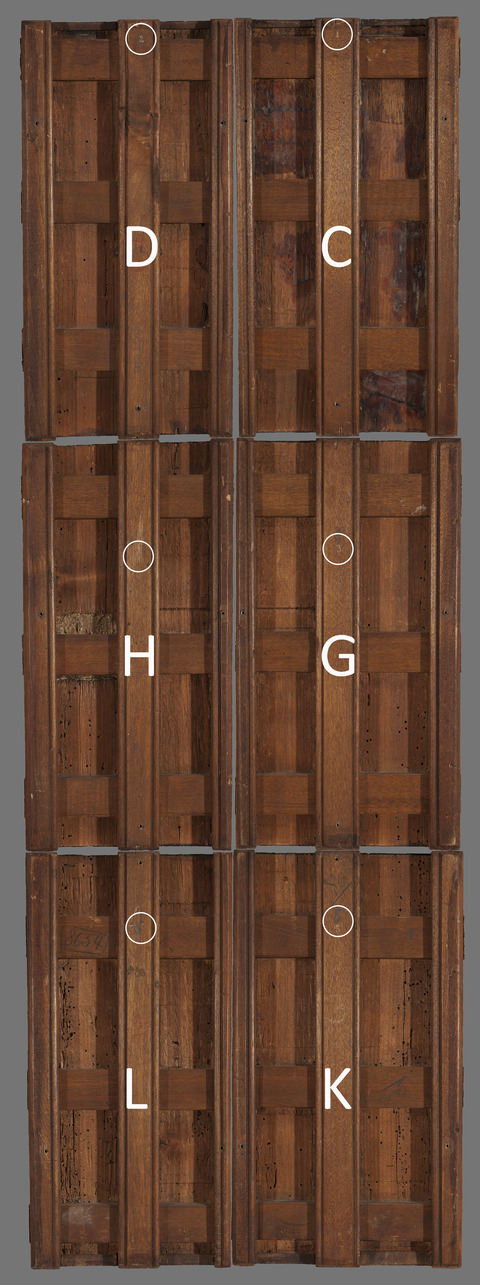
Panels A, B, E, F, I, J
The Last Supper (panel A)
Item 1. Upper portion of the central vertical cradle member, handwritten in blue paint: “I” (tech. fig. 3).
Item 2. Upper portion of the central vertical cradle member, handwritten in red pencil: “1” (tech. fig. 3).
Item 3. Left side of central horizontal cradle member, handwritten in pencil: “1” (tech. fig. 3).
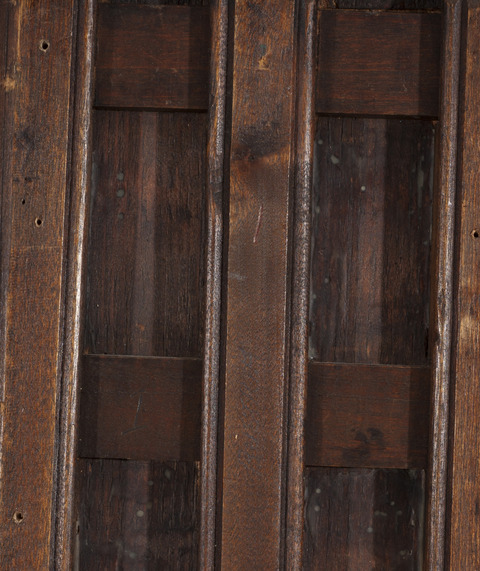
Agony in the Garden (panel B)
Item 4. Upper portion of the central vertical cradle member, handwritten in blue paint: “Ⅱ” (tech. fig. 4).

Item 5. Lower portion of the central vertical cradle member, handwritten in pencil: “AUSTRIA” (tech. fig. 5).
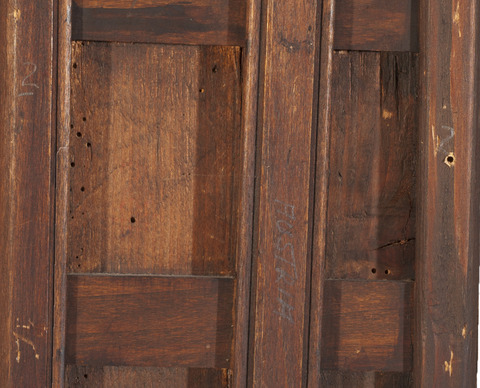
Item 6. Lower portion of the left vertical cradle member, handwritten in pencil: “2” (tech. fig. 5).
Christ at the Column (panel E)
Item 7. Upper portion of the central vertical cradle member, handwritten in blue paint: “Ⅲ” (tech. fig. 6).
Item 8. Upper portion of the central vertical cradle member, handwritten in red pencil: “5” (tech. fig. 6).
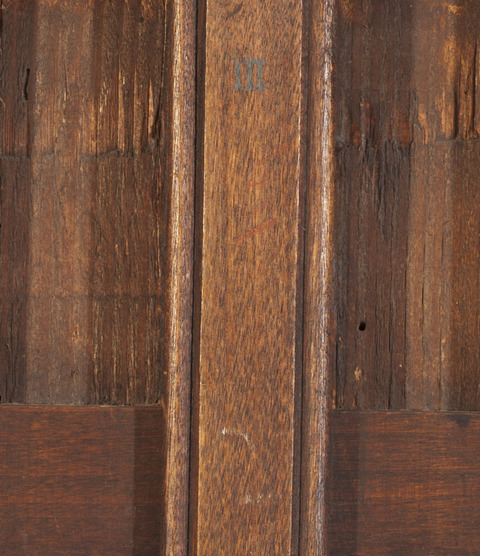
The Mocking of Christ (panel F)
Item 9. Upper portion of the central vertical cradle member, handwritten in blue paint: “IV” (tech. fig. 7).
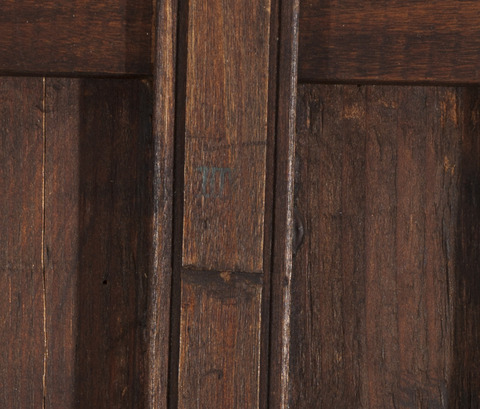
Crucifixion (panel I)
Item 10. Upper portion of the central vertical cradle member, handwritten in blue paint: “V” (tech. fig. 8).
Item 11. Upper portion of the central vertical cradle member, handwritten in red pencil: “9” (tech. fig. 8).
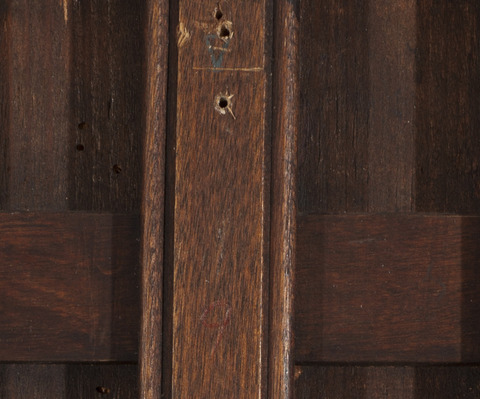
Descent from the Cross (panel J)
Item 12. Upper portion of the central vertical cradle member, handwritten in blue paint: “VI” (tech. fig. 9).
Item 13. Upper portion of the central vertical cradle member, handwritten in red pencil: “10” (tech. fig. 9).
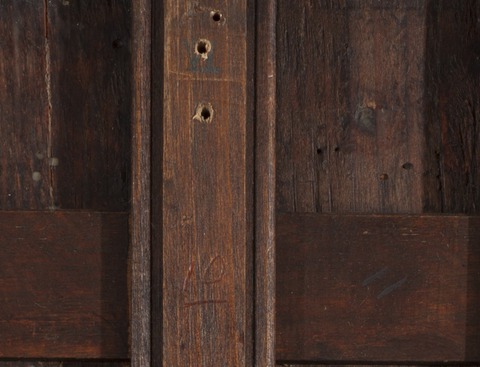
Panels C, D, G, H, K, L
Kiss of Judas (panel C):
Item 14. Upper portion of the central vertical cradle member, number “1” in off-white paint (tech. fig. 10).
Item 15. Center of the central vertical cradle member, handwritten in red pencil: “3” (tech. fig. 10).
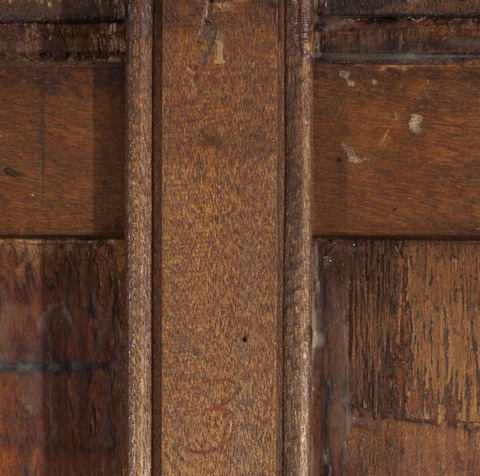
Pilate Washing His Hands (panel D)
Item 16. Upper portion of the central vertical cradle member, number “2” in off-white paint reinforced with pencil (tech. fig. 11).
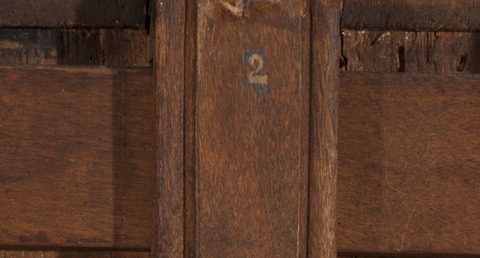
Item 17. Center of the central vertical cradle member, handwritten in red pencil: “4” (tech. fig. 12).
Item 18. Center of the central vertical cradle member, handwritten in pencil: “AUSTRIA” (tech. fig. 12).
Item 19. Right side of the central horizontal cradle member, handwritten in red pencil: “4” (tech. fig. 12).
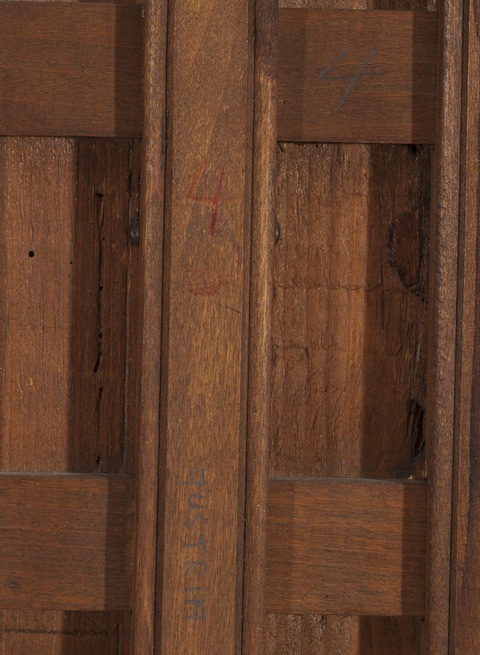
Christ Carrying the Cross (panel G)
Item 20. Upper portion of the central vertical cradle member, number “3” in off-white paint (tech. fig. 13).
Item 21. Upper portion of the central vertical cradle member, handwritten in pencil: “3” (tech. fig. 13).
Item 22. Center of the central vertical cradle member, handwritten in pencil: “7” (tech. fig. 13).
Item 23. Left side of the upper horizontal cradle member, handwritten in pencil: “B” (tech. fig. 13).
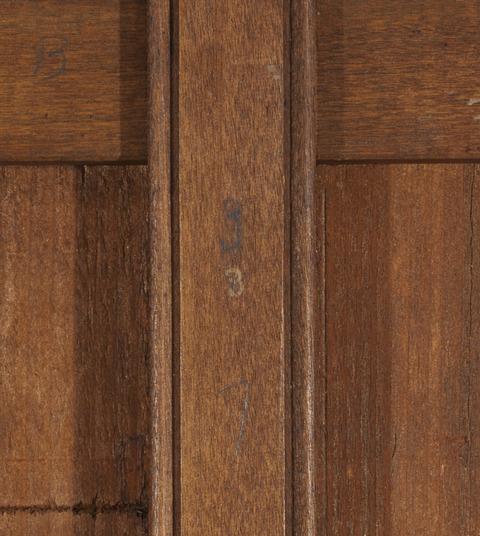
Christ Nailed to the Cross (panel H)
Item 24. Upper portion of the central vertical cradle member, number “4” in off-white paint (tech. fig. 14).
Item 25. Upper portion of the central vertical cradle member, handwritten in red pencil: “8” (tech. fig. 14).
Item 26. Back of the panel above the right side of the central horizontal cradle member, handwritten in pencil: “8” (tech. fig. 14).
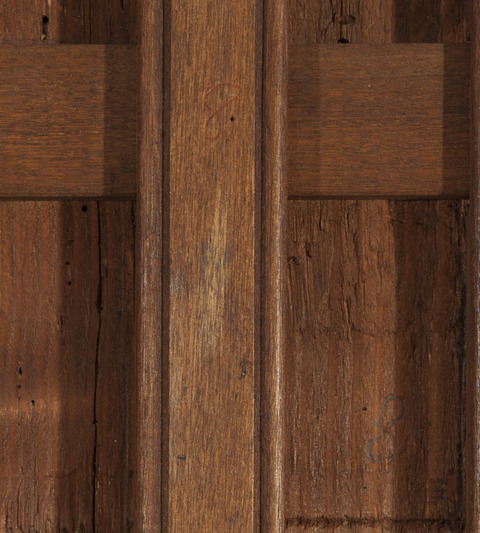
Item 27. Center of the central vertical cradle member, handwritten in pencil “AUSTRIA” (tech. fig. 15).
Item 28. Lower portion of the central vertical cradle member, handwritten in red pencil: “8” (tech. fig. 15).

Entombment (panel K)
Item 29. Top of central vertical member, number “5” in off-white paint (tech. fig. 16).
Item 30. Top of central vertical member, handwritten upside-down in pencil: “865/5” (tech. fig. 16).
Item 31. Upper portion of the central vertical cradle member, handwritten in red pencil: “11” (tech. fig. 16).
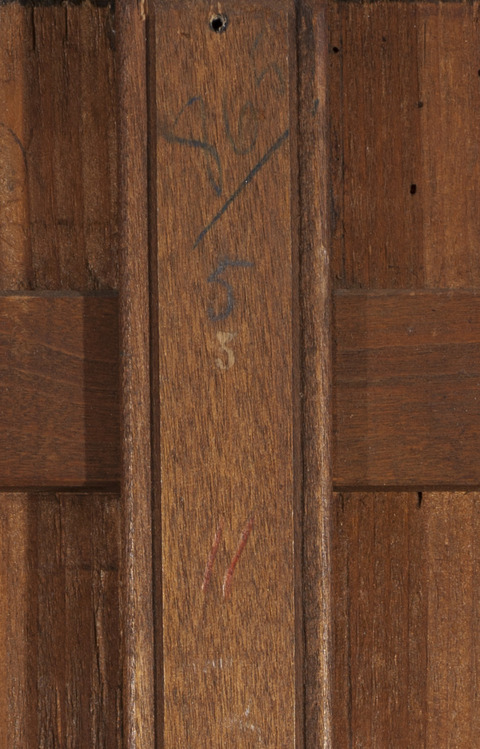
Item 32. Right side of central horizontal cradle member, handwritten upside-down in pencil: “Centre” (tech. fig. 17).
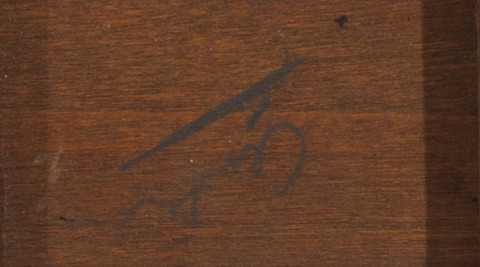
Resurrection (panel L)
Item 33. Upper portion of the central vertical cradle member, handwritten in pencil reinforcing off-white paint: “6” (tech. fig. 18).
Item 34. Upper portion of the central vertical cradle member, handwritten numbers in dark blue-green pencil crayon: “8654” (tech. fig. 18).
Item 35. Upper portion of the central vertical cradle member, handwritten in red pencil: “12” (tech. fig. 18).
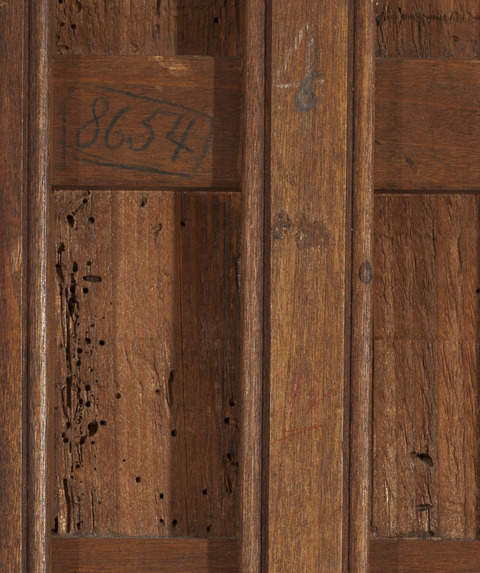
Summary of Treatment History
Numerous interventions were executed before the panels arrived at the IMA in 1971, including the separation of the 12 scenes from their original formation into individual vignettes, thinning of the panels, and the addition of the cradles. According to records on file at the Indianapolis Museum of Art, the panels were treated in 1963 and in 2006, and numerous condition assessments were carried out.
Before arriving at the IMA, Louis Pomerantz treated the paintings in 1963.1 Treatments listed in the conservation file from this intervention include:
-
Descent from the Cross (panel J): “Fixed paint cleavage with a wax-resin adhesive (lining formula). Infused and filled rear of panel with a wax-resin adhesive in worm holes and splits. Coated all sides, rear and cradle, with carnauba wax. Filled tiny paint losses with pigmented wax and varnished these areas only.”
-
The Last Supper (panel A): “Paint losses along borders were filled with pigmented wax, inpainting of all losses was executed with acrylic resin colors (Dupont Lucite 46). The painting was sprayed with acrylic resin varnish (Acryloid B82 Rohm and Haas). The rear of the panel was filled with wax-resin adhesive in areas of worm holes and coated all sides and cradle with carnauba wax and polished.”
-
Kiss of Judas (panel C): “Fixed paint cleavage areas with a wax-resin adhesive (lining formula) and filled losses along borders and cleavages with pigmented wax. Filled split and knot and worm holes at rear of panel with wax-resin adhesive. Coated all sides of panel and rear and cradle with carnauba wax. Inpainted losses with pigments ground in acrylic type resin (Lucite-46 from Dupont), and sprayed painting with acrylic resin varnish (Acryloid B82 from Rohm and Haas).”
A condition report by Paul Spheeris from October of 1971, likely carried out before the paintings were relocated to the IMA, wrote that the “11th panel is chipped and the loss is in the lower left corner, also the frame is chipped.” He suggested that cleaning would be beneficial for the sake of the appearance but not for the safety of the painting.2
The most recent treatment, completed by David Miller in 2006, involved consolidation with isinglass “Sea Gel,” surface cleaning with deionized water at a pH of 7.0, filling with Modostuc, spray varnishing with 5% Paraloid B-72 (in 1:1 xylene: toluene), inpainting with Gamblin Conservation Colors in isopropanol (Laropal A-81), and final spray varnish of 5% Paraloid B-72 (in 1:1 xylene: toluene).
All the panels were examined and the condition recorded in the Clowes Collection annual survey from 2011 to 2020.
Current Condition Summary
The panels are in stable structural condition. Aesthetically, they are in fair condition but have a significant amount of retouching present as well as obvious restoration campaigns in the gilding. A discolored natural resin varnish is also present, imparting a yellowed appearance to most of the colors.
Methods of Examination, Imaging, and Analysis
| Examination/Imaging | Analysis (no sample required) | Analysis (sample required) |
|---|---|---|
| Unaided eye | Dendrochronology | Microchemical analysis |
| Optical microscopy | Wood identification | Fiber ID |
| Incident light | Microchemical analysis | Cross-section sampling |
| Raking light | Thread count analysis | Dispersed pigment sample |
| Reflected/specular light | X-ray fluorescence spectroscopy (XRF) | Fourier-transform infrared spectroscopy (FTIR) |
| Transmitted light | Macro X-ray fluorescence scanning (MA-XRF) | Raman microspectroscopy |
| Ultraviolet-induced visible fluorescence (UV) | ||
| Infrared reflectography (IRR) | Gas chromatography–mass spectrometry (GC-MS) | |
| Infrared transmittography (IRT) | Scanning electron microscope -energy dispersive X-ray spectroscopy (SEM-EDS) | |
| Infrared luminescence | Other: | |
| X-radiography |
Technical Examination
Description of Support
Analyzed Observed
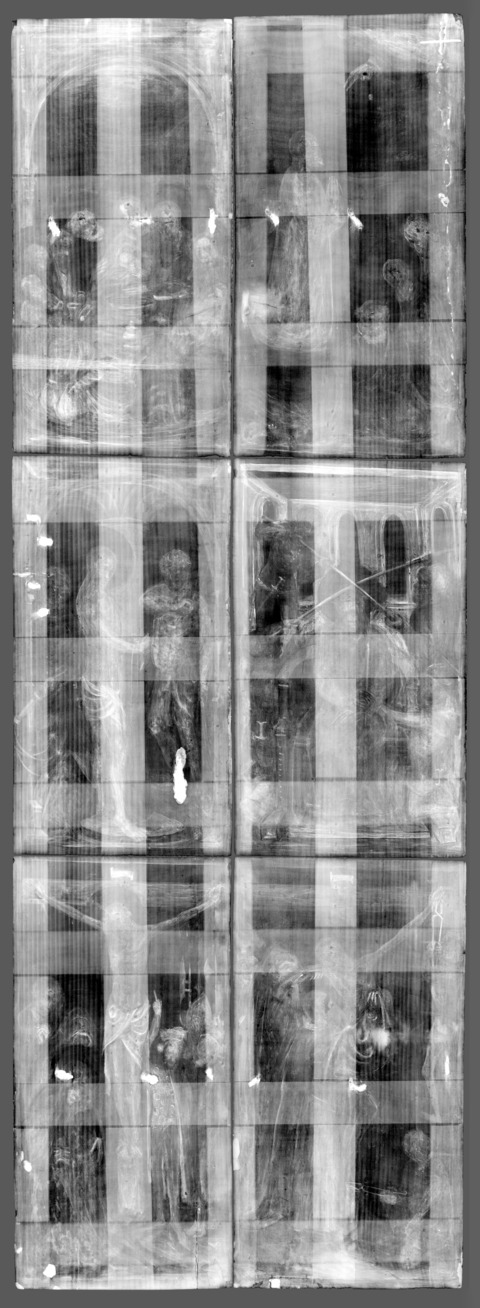
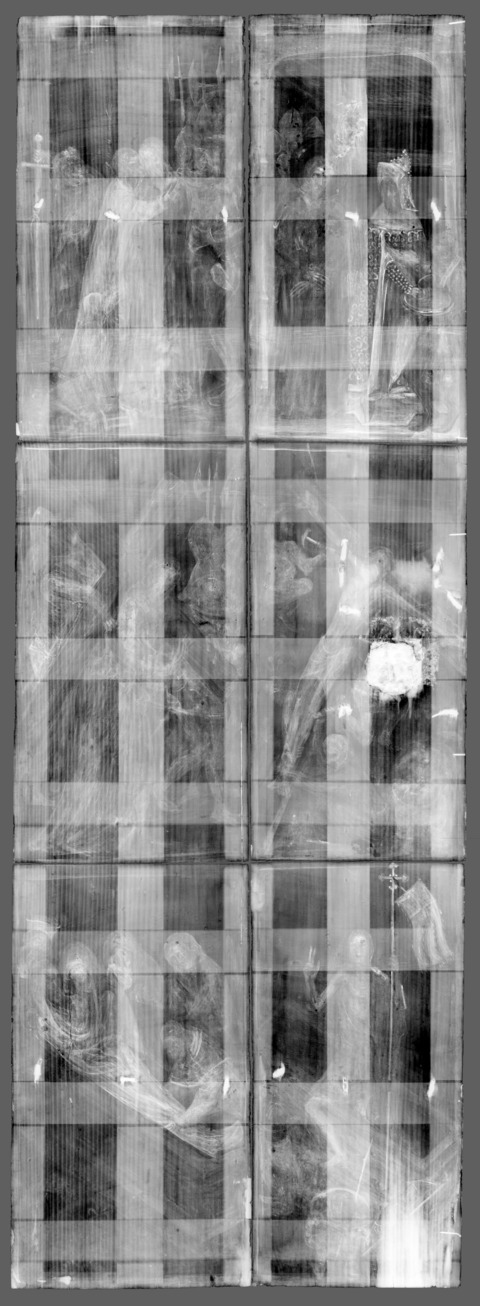
Material (fabric, wood, metal, dendrochronology results, fiber ID information, etc.):
The wood of the panels was sampled for wood identification by wood specialist Peter Klein.3 The wood species was identified as silver fir (Abies alba).4 Fir would have typically been used in South Germany or Austria, but also in more northern areas like Cologne.5
Characteristics of Construction / Fabrication (cusping, beveled edges of panels, seams, joins, battens):
The original construction of the support was two large panels each depicting six scenes of the Passion of Christ. The 12 scenes have been cut into individual vignettes from two large panels. It is possible that additional panels were painted, such as a central panel for a triptych, and have since been lost. During the process of preparing the panels for painting, the two large supports were covered in canvas, likely adhered with gesso and glue layers, as would have been common practice in panel prepration in the early fifteenth century (tech. fig. 21).
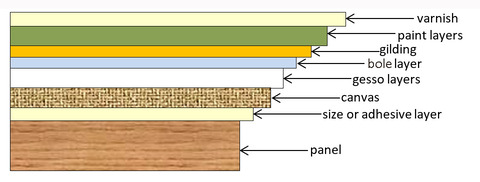
Along the edges of some of the the original panels, the canvas can be observed. The canvas can also be observed in the X-radiographs (tech. fig. 22). It extends to the edges of all 12 panels, suggesting no major structural additions were made to the edges.
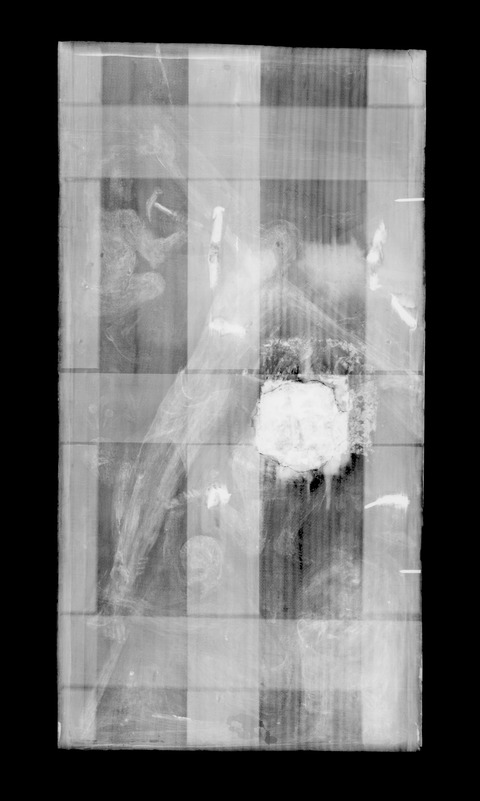
The wood grain is vertically oriented throughout all panels, showing continuity and thus the original layout of the work, wherein the narrative continues across the top row of both panels before moving to the next row (tech. figs. 19, 20). In their original dimensions, the two large panels were thinned, and a cradle was added sometime in the twentieth century. Subsequently, the cradled panels were cut into 12 individual vignettes, presumably to increase their resale value (as they were later sold in three series of four panels). Veneer was attached to the edges of the right and left side (although not the upper and lower edges) with glue and finishing nails. The backs of the panels were stained dark brown, presumably to mimic the age of the original wood. The panel now composed of segments A, B, E, F, I, and J was stained a darker color (tech. figs. 24) than the other panel composed of segments C, D, G, H, K and L (tech. fig. 26). This confirms that the staining was applied before the division and reorientation of the panels (see fig. 1).
Thickness (for panels or boards):
0.6–0.8 cm (without cradle)
Production/Dealer’s marks:
None
Auxiliary Support:
Original Not original Not able to discern None
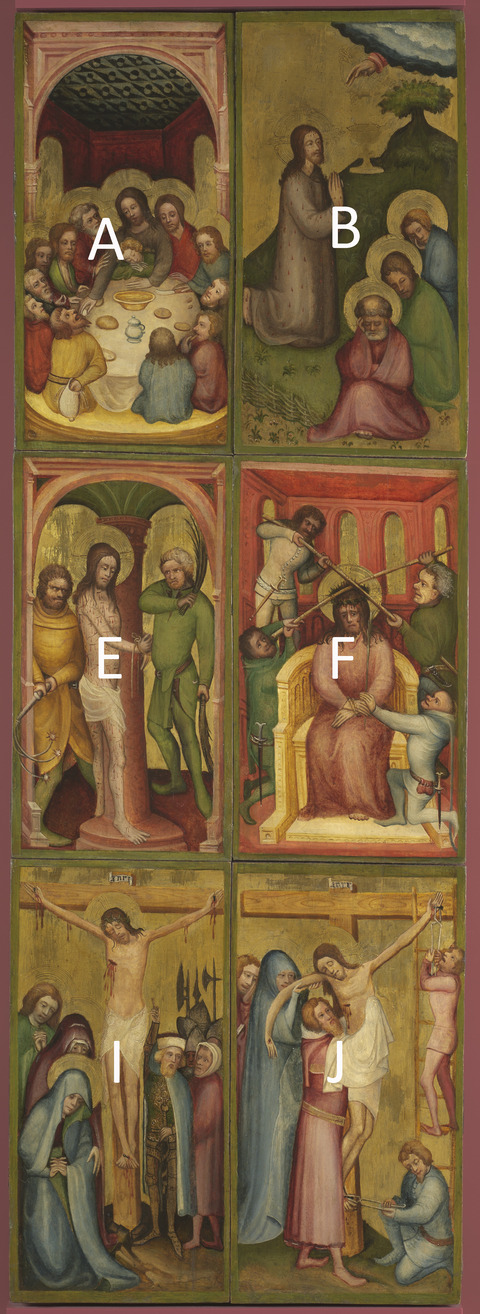

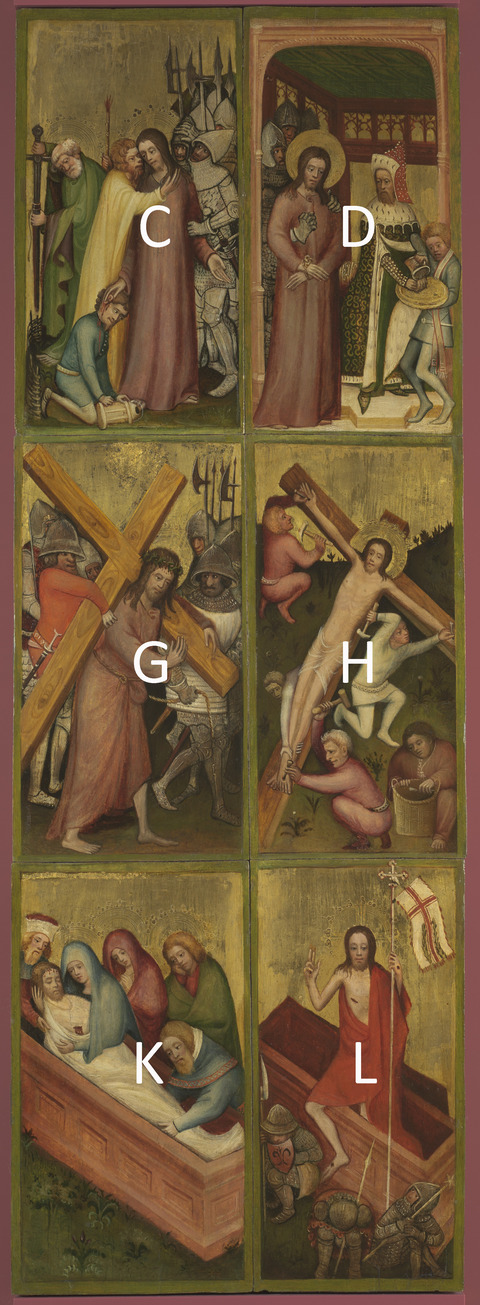
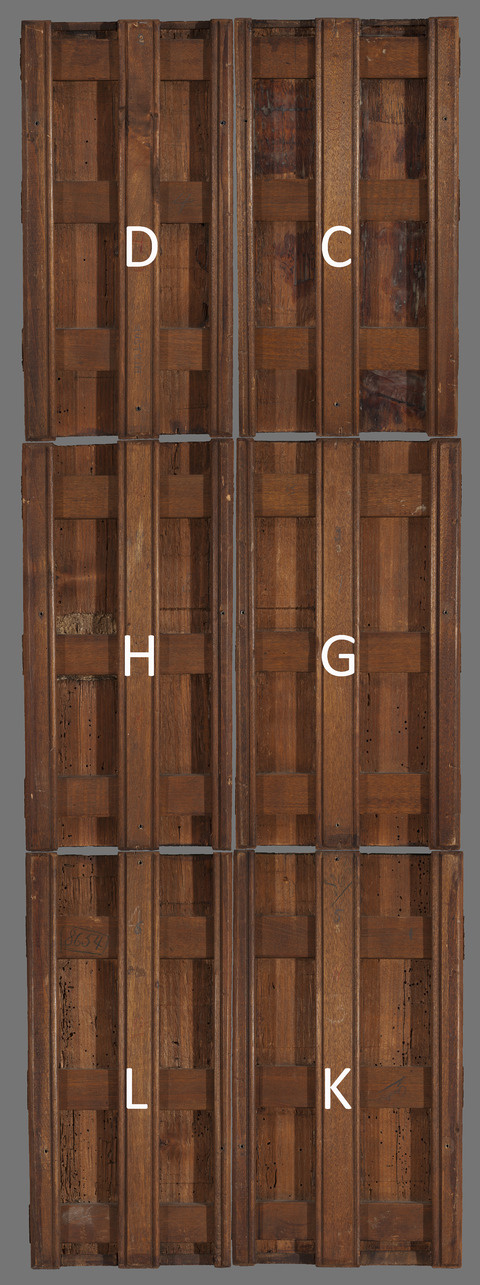
Attachment to Auxiliary Support:
Before the panels were divided into segments, cradles were glued to the back of the thinned panels. The cradles are nearly identical in their construction and application (tech. figs. 24, 26), indicating they were applied at the same time by the same restorer. The cradle member on the right side of panel B appears to have been added after the division of the panels, as the central cradle member was applied at a slight angle leaving the central cradle member almost completely on panel A after the panels were divided. This resulted in the right side of panel B having no support, and an addition was made to the right side. Most of the horizonal cradle members have seized, but they were originally designed to slide, allowing the wood to expand. The cradle members were rounded at the edges, presumably at the time the panels were cut apart, to give each panel a more individualized identity (and possibly to increase profits if each panel were to be sold separately).
Condition of Support
The original panels were damaged due to woodworm tunneling, which is primarily present at the outer edges. The panels were kept in their orientation during the technical examination, such that the inner edges of the panels that are adjacent to each other could not always be seen. Some warping of the wood has created splitting and checks in the original panel. Both the woodworm damage and the splits were stabilized, and there is no evidence of any ongoing infestation. A wax-resin layer was added to three of the panels to fill and stabilize the wood tunneling. There are some fills and veneer strips along some of the edges. These strips have been worn away in certain areas, revealing the original edges of the panels. The wood support is currently stable with no evidence of recent damage or infestation. Nicks and dents are present throughout the support and cradle. Below is a detailed description of the support as it relates to each panel.
The Last Supper (panel A):
The wood support is darker than the other panels due to an additional wax coating applied in 1963. A wooden lip has been added to the back of the original panel along the top edge. This lip appears to be fitted around the cradle members. Several scratches, nicks and dents are present throughout the back. There is a 12 cm-long split in the back on the left side as well as several checks in the wood. Some woodworm damage is visible on the back, but the holes have been filled with wax. A wood veneer is attached to the left edge6 but is partially worn away.
Agony in the Garden (panel B):
A wooden veneer is attached to the right edge, and one tack can be seen in the X-radiograph. Some woodworm damage is visible on the back. A knot is present in the wood along the left side of the panel, and this can be seen on the front in the form of a horizontal line in the Jesus figure’s gray robe. Nicks and dents are present throughout the whole panel and cradle, with newer ones revealing the lighter color of the wood prior to the application of the wood stain. The rightmost cradle member, as viewed from the back, was a newer addition after the panel was cut into pieces, as the central cradle member would have ended up almost completely on panel A due to the angle of the cut (tech. fig. 24).
Kiss of Judas (panel C):
The wood support is slightly darker due to wax infusion from a previous treatment in 1963. Several splits and checks are present in the original panel. It appears that the top edge was partially sawn through (at ~1.2 cm in from the top), but the canvas is present over the entire surface, indicating that the top edge is part of the original panel. A wooden lip has been added to the back of the original panel along the top edge. This lip appears to be fitted around the cradle members. A wood veneer is attached to the left edge. Some woodworm damage is visible, and saw marks are present along all edges. Slight loss of the wooden support is present along the upper-left edge, revealing the ground and canvas layer.
Pilate Washing His Hands (panel D):
Wormholes are present in several areas. All three horizontal cradle members are slightly movable. Saw marks are visible along all edges. A wooden lip has been added to the back of the original panel along the top edge. This lip appears to be fitted around the cradle members. A wood veneer is attached to the right edge.
Christ at the Column (panel E):
Wormholes are present in several areas. A wooden strip is attached to the left edge and is slightly worn along the bottom half, revealing the edge of the original panel. The canvas can be seen in the X-radiograph extending over the entire panel, although the right edge might have some additional fill material obscuring a small section in this area.
The Mocking of Christ (panel F):
Wormholes are present in several areas. A wooden edge strip is attached to the right edge. A large split is present between the first two cradle members (when viewed from the back) and runs the entire length of the panel. This is also evident through the paint layer. It appears that the split occurred sometime after the wood stain was applied to the cradle, as the wood stain is not present in the split. Nicks and dents are present throughout the whole panel and cradle, with newer ones revealing the lighter color of the wood. Diagonal scratches are present on the back in the lower left and right quadrants. These extend onto the back of Christ at the Column (panel E). The rightmost vertical cradle member is much smaller due to the way the panel was cut. A wood veneer is attached to the right edge.
Christ Carrying the Cross (panel G):
A horizontal saw mark on the back is present just above the central horizontal cradle member. Woodworm tunneling is present closer to the outer edge, and a section of edge strip is missing along the left edge revealing further woodworm tunneling. A loss of the wooden support is present in the upper-left corner. A 14 cm-long hairline crack in the wood is visible on the right edge of the back. A wood veneer is attached to the left and right edges, although the veneer on the right edge appears to be largely abraded.
Christ Nailed to the Cross (panel H):
The panel suffered significant damages in the past. Three splits are present and can be seen in the back, measuring 15, 10, and 4 cm. A larger area of damage in the shape of a square can be clearly seen on the X-radiograph as well as on the back of the panel. The square loss could have occurred during the thinning of the panel before the addition of the cradle. The area of damage was then filled with canvas, gesso, and lead white. The damage can also be seen from the front of the painting. A wood veneer edge strip was added to the right edge, and two nails are present holding the thin edge strip in place. Woodworm holes are present and are primarily located near the left edge, from the back.
Crucifixion (panel I):
A large split is present along the left side of the back, measuring the entire length of the panel. Some woodworm holes are present, although not nearly as extensive as in the other panels. The cradle members are all seized, although the topmost member could be moved with more force. A lip has been added to the back along the lower edge, possibly related to previous display. Wood veneer was added to the left edge. A large split along the right edge runs the entire length of the panel. When seen from the back, the split appears dark and likely occurred before the cradle and back of the panel were stained with wood stain.
Descent from the Cross (panel J):
Wormholes are present in several areas. A wooden edge strip is attached to the left edge. Nicks and dents are present throughout the entire panel and cradle. A lip has been added to the back along the lower edge. Wood veneer was added to the right edge.
Entombment (panel K):
A lip has been added to the back along the lower edge. Wood veneer was added to the left edge. A section of the edge veneer is missing along the central horizontal cradle member revealing the side of the original panel. A lip has been added to the lower edge of the panel between the vertical cradle members. A vertical split approximately 32 cm long is present along the right side of the back of the support, located between two vertical cradle members. The horizontal cradle members are seized, although the topmost one could possibly move with more force. Woodworm tunneling is present, primarily along the right edge of the back. Horizontal tool marks are present on the back of the thinned panel, likely related to a saw or thinning blades. Some fills are present at the corners, and additional losses in the wood are present along the bottom edge of the panel.
Resurrection (panel L):
A wooden lip has been glued to the lower edge of the panel between the vertical cradle members, possibly for previous display purposes. A veneer edge strip is added to the right side, and one tack is visible in the X-radiograph. Most of the edge strip on the right edge is missing, revealing the original edge of the panel along with some woodworm damage. A large fill is present along the bottom edge, where it appears the canvas is beneath the wood. The fill was applied over the canvas and mimics the surrounding area. Significant woodworm tunneling is present along the left edge of the back of the panel. Horizontal tool marks are present on the back of the thinned panel, likely related to the saw or thinning blades.
Description of Ground
Analyzed Observed

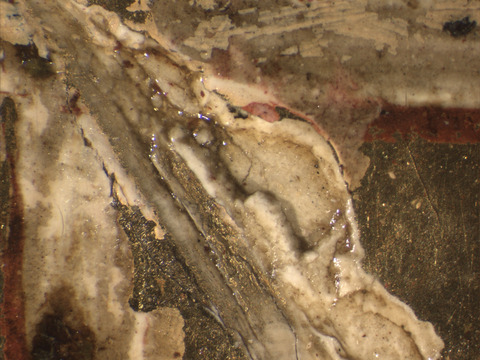
Materials/Binding Medium:
The binding medium is likely animal glue, but this has not been analyzed.
Color:
The color of both ground layers is off-white (tech. fig. 27). A black bole layer is present over the ground layers in areas of gilding. This can be seen in losses on Christ Carrying the Cross (panel G) (tech. fig. 28). On other panels, the black bole is less easily identifiable but is also present in areas of water gilding.
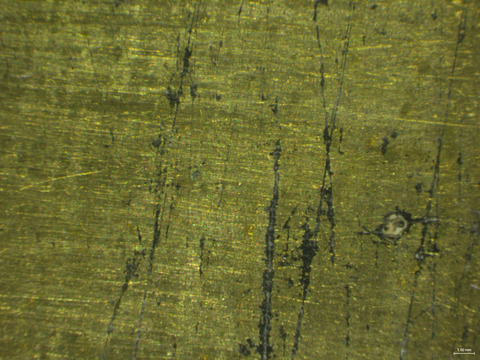
Application:
The ground appears to have been applied by brush over the entire surface of the canvas-covered panel. Since a significant amount of gilding is present, the ground layer was likely sanded or smoothed to prepare for the bole layers and subsequent water gilding.
Thickness:
The ground appears to be applied in two relatively thick layers. These layers can be observed in the Resurrection (panel L, see tech. fig. 27).
Sizing:
While not visible, sizing would have been applied to the panel prior to the canvas as a means of securing the canvas to the panel.
Character and Appearance (Does texture of support remain detectable / prominent?):
The ground was applied quite thickly so that the canvas support is not detectable through the paint layers. Over time, the cracking in the panel caused a craquelure network in the ground like that found in many panel paintings. The warp of the two large panels (before being cut into segments) was flattened by the application of cradles to the back. Vertical cracking in the panels was caused by the cradle’s restriction of the wood’s movement in response to environmental conditions. These remain distinctly detectable through the ground and paint layer. Otherwise, the wood grain itself is not prominent in any of the 12 panels.
Condition of Ground
Overall, the ground layer is in good condition. Where visible in the cracks, the ground appears to be well adhered to the canvas as well as to the paint layers. Some losses have occurred throughout the panels, particularly along the edges where the two larger panels were each cut into six smaller panels. In many of these edges, the losses were subsequently filled. In the X-radiographs, the losses in the ground appear much brighter, as they are filled with a more X-ray-dense material. Frequently, the areas of loss are in cradled areas, and it is possible that the losses are to the panel itself; however, it is difficult to tell as the combination of the cradle members and the lead white obscure the original panel from view.
Description of Composition Planning
Methods of Analysis:
Surface observation (unaided or with magnification)
Infrared reflectography (IRR)
X-radiography
Analysis Parameters:
| X-radiography equipment | GE Inspection Technologies Type: ERESCO 200MFR 3.1, Tube S/N: MIR 201E 58-2812, EN 12543: 1.0mm, Filter: 0.8mm Be + 2mm Al |
|---|---|
| KV: | Unknown (Completed in 2012 and not recorded) |
| mA: | 3.0 (standard) |
| Exposure time (s) | Unknown (Completed in 2012 and not recorded) |
| Distance from X-ray tube: | 36″ (standard) |
| IRR equipment and wavelength | Opus Instruments Osiris A1 infrared camera with InGaAs array detector operating at a wavelength of 0.9-1.7µm. |
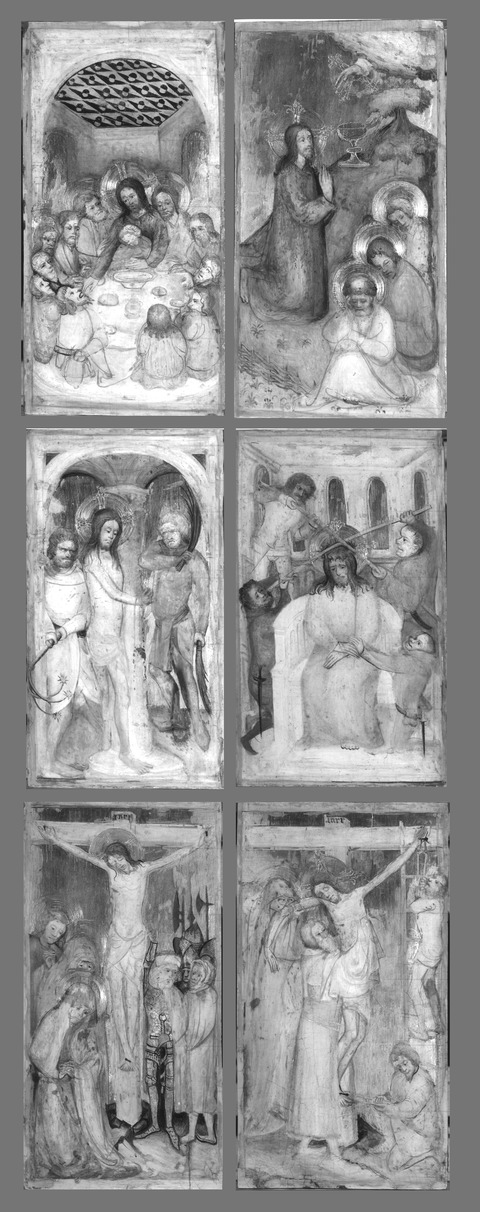
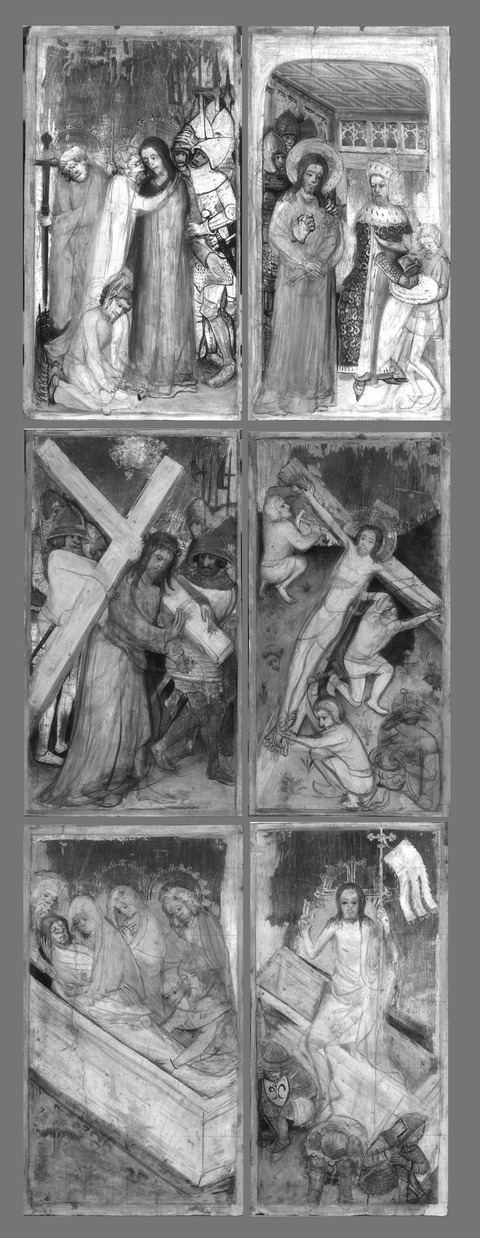
Medium/Technique:
Distinctive underdrawing in a liquid medium was applied over the ground layer and can be observed in infrared reflectography (tech. figs. 29, 30). This distinctive underdrawing can be observed on all panels with some lines appearing quite dark (almost black) while others are much lighter. This difference is likely due to varying amounts of carbon in the medium and their respective reflectance in the infrared region of the spectrum.
Incision lines are also present at the border of the gilded and painted regions of the composition (tech. fig. 31). Incised lines were clearly applied by the artist/workshop to differentiate between compositional elements requiring gold leaf (often the background) and areas that would be left ungilded.
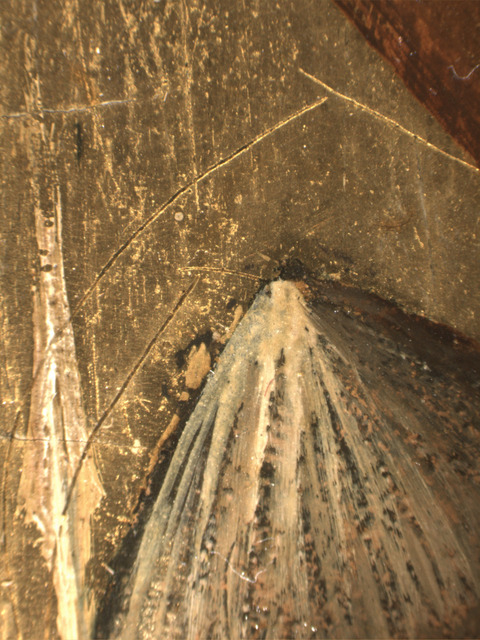
Pentimenti:
The combination of lighter and darker underdrawing indicates that several materials were used during the planning stage, possibly by different hands. The composition was planned out, especially since gilding would add to the expense of the materials. Despite the planning, the underdrawing maintains a level of fluidity and exhibits significant adjustments and refinements (possibly by the work of another or several hands) that are remarkable. Some lines are heavily reinforced, while others are only lightly adjusted. Most of the robes and figures have outlines and slight adjustments made to them; however, a few panels have more significant changes. The more prominent changes in the panels are described in further detail below:
The Last Supper (panel A)
Changes were made to the figures on the right. One figure originally looked out at the viewer before later being adjusted to look upward. Some of the outlines overlap, indicating the order in which they were drawn (tech. fig. 32).
Kiss of Judas (panel C)
Bold outlines are present in the soldier’s armor. Significant adjustments are present in the kneeling servant’s position as well as minor alteration of the robes (tech. fig. 33).
Pilate Washing His Hands (panel D)
Adjustments were made to Jesus’s arms and hands and to the servant boy’s legs—initially the right leg was straight before later being adjusted so that both legs are now slightly bent. The soldiers were initially drawn to overlap the border edges, much like the servant, but later hidden by the border during the painting process (tech. fig. 34).
Christ Nailed to the Cross (panel H)
Significant adjustments were made to the bottom-right figure, who was significantly altered, as was the basket. Changes were made in the position of the leg of the hammering figure in the bottom part of the composition. Adjustments were made to Jesus’s feet as well as minor reinforcements of outlines of his body. The right arm of the figure to the far right was once reaching up toward the cross but was readjusted (tech. fig. 35).
Entombment (panel K)
Major adjustments were executed to the rightmost figure’s position and shape of the head, while smaller reinforcements and outlining are present throughout (tech. fig. 36).
Resurrection (panel L)
Adjustments were made to the soldiers' outlines as well as the size and position of the feet of the solder to the far left. Adjustments were made to the Christ figure’s leg shape (tech. fig. 37).
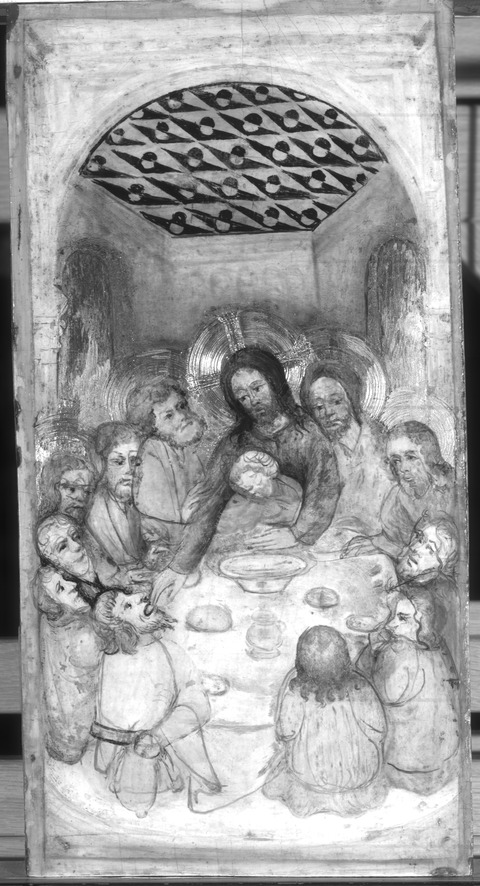
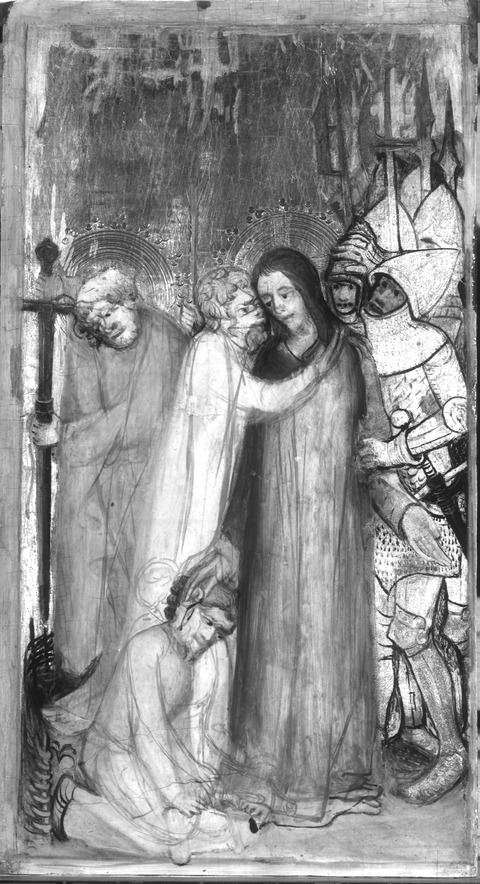
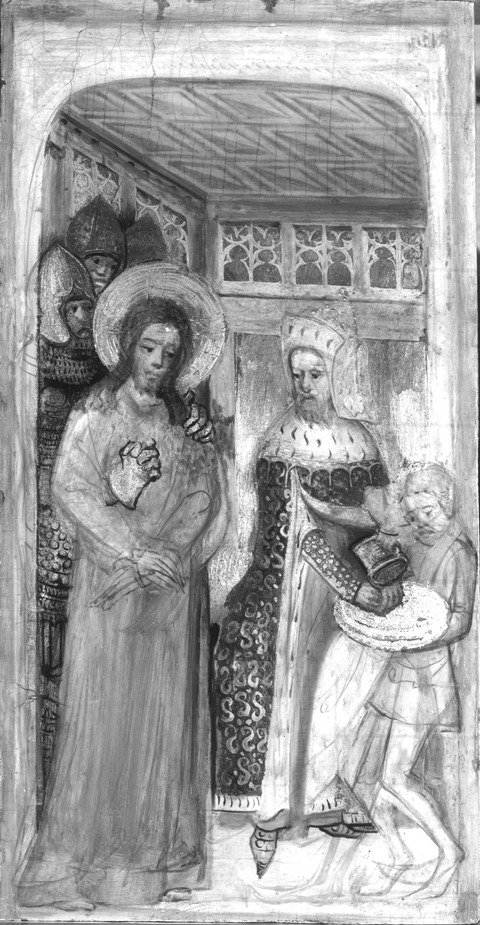
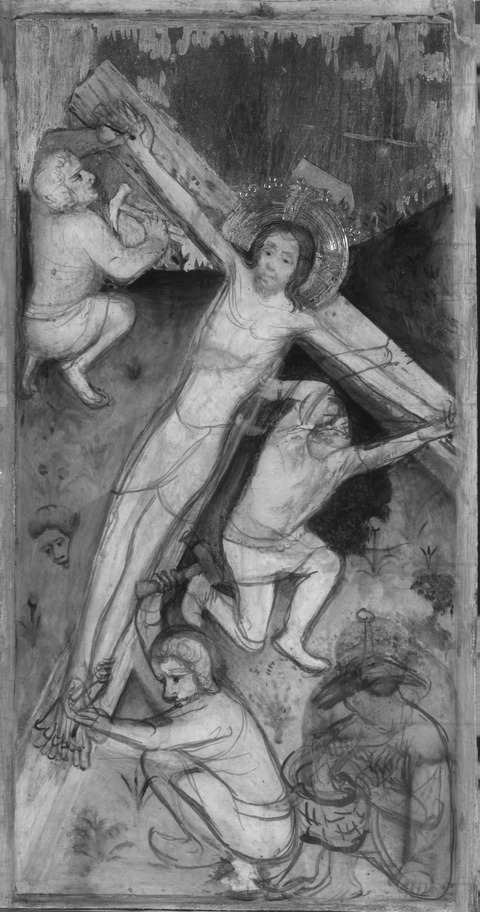
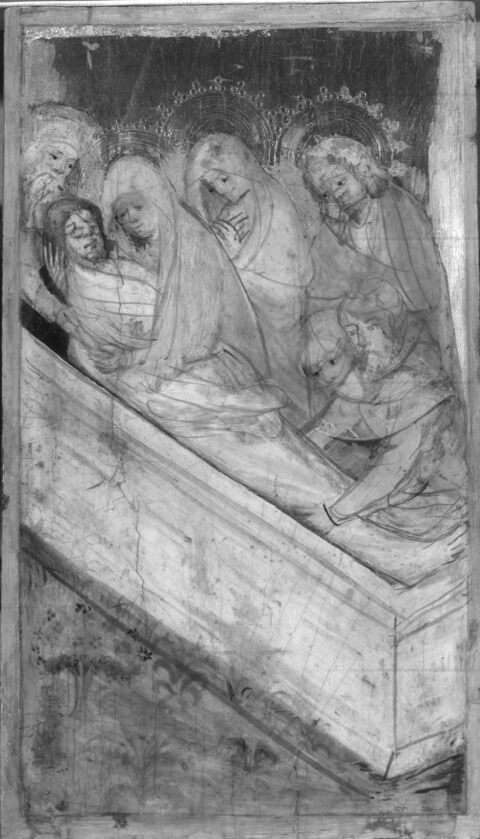
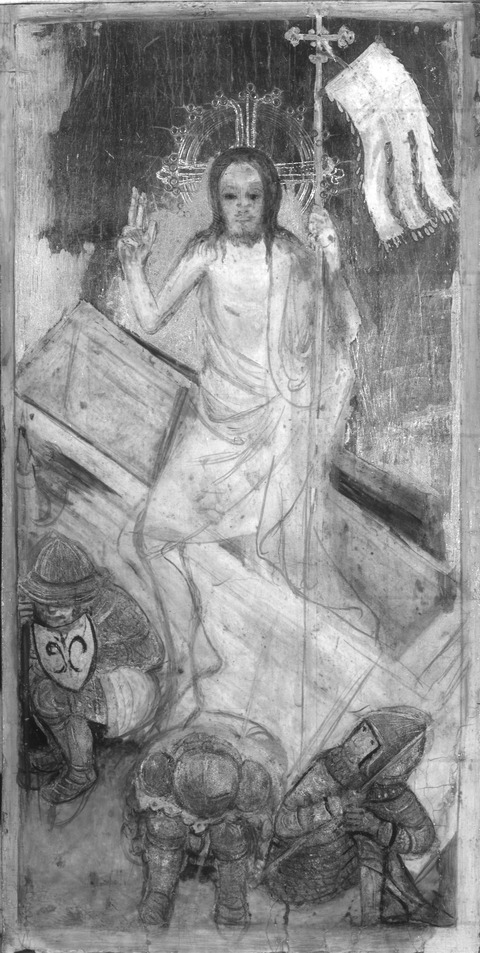
Description of Paint
Analyzed Observed
Application and Technique:
Gold leaf was applied over the white gesso primarily in the background. It appears that the panels were originally water gilded, and the gilding was burnished to give a brilliant surface, but later gilding restorations were not applied using the same technique. Presently, extensive mordant gilding and shell gold restoration are present on the panels. The compositions were planned to incorporate the expensive gold only where needed, with incised lines indicating general outlines of the composition. Decorative punchwork, using a single circular punch (tech. fig. 38), was used in the halos. A single dot punch was also used in Christ’s halo to create freehand patterns (tech. fig. 39).
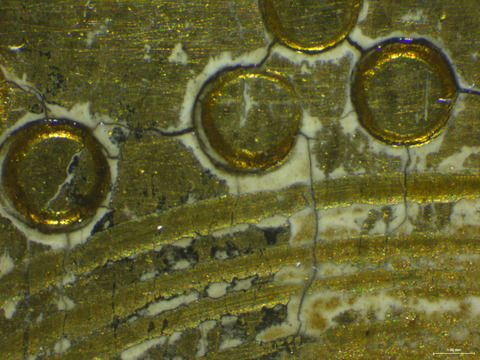
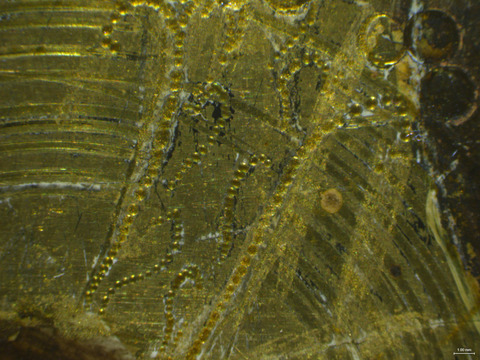
Egg tempera was applied in layers following the design of the composition that was established using underdrawing. However, the brushstrokes do not have the controlled, hatched application that is typical of egg tempera technique. Rather, the paint was applied quickly and with gestural brushstrokes. More careful, delicate rendering is present in the faces of the figures (tech. fig. 40), particularly the Christ figure. It is possible that extensive retouching has muddied the appreciation of a once carefully hatched technique.
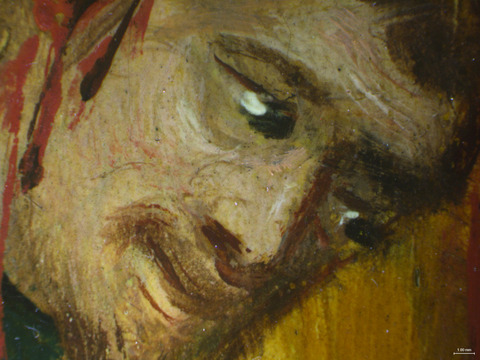
Painting Tools:
The paint was applied using small brushes. Gilding tools and punches were also used.
Binding Media:
FTIR analysis was conducted to determine the binding medium on a sample taken from a loss to the white paint of the flag on Resurrection (panel L). The spectrum was compared to both aged linseed oil as well as aged egg yolk. The sample spectrum in the protein regions has significant similarities to that of the egg yolk spectrum, indicating that egg tempera was most likely the binding material for the original paint layer.
Color Palette:
Most of the scenes are painted against a gold background. The gilding is visible through some areas of the paint, indicating that the paint was applied after the gilding, as was common practice. The gilding was applied relatively precisely and does not extend beneath all the figures and elements of the composition. Bright and relatively unmixed colors were used in much of the composition. Each panel has an olive green border. It appears that most of the borders were repainted during a conservation campaign, and the retouching extends beyond damages and over the edges of the panels. The borders of the scenes would have originally delineated each vignette and established the narrative progression on the panels. In Kiss of Judas (panel C), the composition extends over the lower border, indicating that the border was well integrated into the composition and painted before the completion of the narrative scene. This also occurs in Christ at the Column (panel E), where the left green edge is covered by the whip; Pilate Washing His Hands (panel D), where the servant’s arm and foot cover the right green edge; and in Resurrection (panel L), where Jesus’s staff extends over the top edge and has the dramatic effect of breaking the plane of the painting.
XRF Analysis:
XRF analysis indicates that the pigments likely used in the composition include lead white, earth pigments (ochres, umber, red earth, etc.), copper-containing blue and/or green pigments such as azurite and malachite, and a small amount of lead-tin yellow (tech. figs. 41, 42). Small peaks for mercury were detected in the skin tones and some reds such as Christ’s robe in panel L (table 1, sample 20), suggesting the use of vermilion in these areas. However, some passage of red showed no strong peaks for either mercury or iron (table 1, sample 15). This suggests these reds were not painted with vermilion or iron oxide. It is likely that these passages were painted using a red lake pigment, but this cannot be confirmed using XRF. The presence of gold and silver was also confirmed, suggesting the use of gold and silver leaf. The detection of zinc indicates the presence of significant restoration using zinc white, which would have been available after 1834. Strong peaks for chromium were also detected, particularly in the green borders where chromium-containing yellow and/or green may have been used in the retouching (table 1, sample 8, 12, 13).
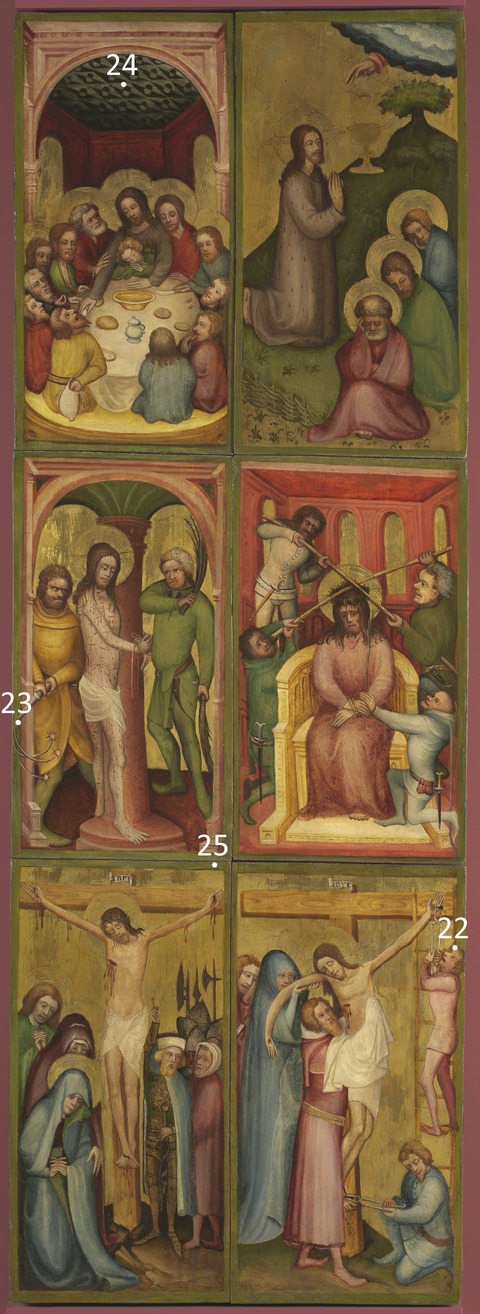
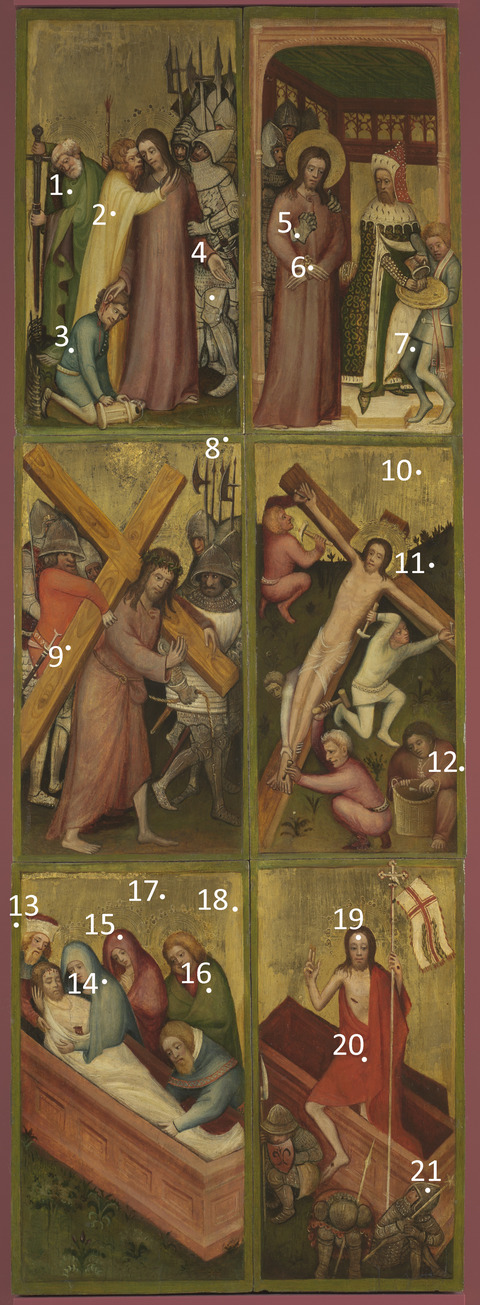
| Sample | Location (x, y) | Elements | Possible Pigments |
|---|---|---|---|
| 1 | Panel C, green cloak (7, 22 cm) | Major: Cu, Pb Minor: Ca, Fe Trace: Sn | Copper-containing blue and/or green pigment, lead white, calcium (from ground layer), iron oxide (earth pigments), traces of lead-tin yellow. |
| 2 | Panel C, white cloak Judas (9, 18 cm) | Major: Pb Minor: Ca Trace: Fe, Cu | Lead white, calcium (from ground layer), iron oxide (earth pigments), trace of copper-containing blue and/or green pigment. |
| 3 | Panel C, blue in clothing (7, 10.5 cm) | Major: Pb, Cu Minor: Trace: Ca, Fe | Copper-containing blue and/or green pigment, lead white, trace of calcium (from ground layer), trace of iron oxide (earth pigments). |
| 4 | Panel C, silver in armor (17, 12 cm) | Major: Pb Minor: Ag, Fe, Hg, Ca Trace: Cu, Zn | Lead white, silver leaf, iron oxide (earth pigments), vermilion, calcium (from ground layer), trace of zinc white (retouching), trace of copper-containing blue and/or green pigment. |
| 5 | Panel D, black in outline of soldier’s glove (6, 18 cm) | Major: Pb Minor: Ca, Cu, Fe Trace: Zn, Hg, Mn | Lead white, calcium (from ground layer), iron oxide (earth pigments), trace of copper-containing blue and/or green pigment, trace of vermilion, zinc white (retouching) |
| 6 | Panel D, Christ’s hand (5.5, 14 cm) | Major: Pb, Cu Minor: Zn, Hg, Fe Trace: Ca, Ba | Lead white, copper-containing blue and/or green pigment, vermilion, zinc white (retouching), iron oxide (earth pigments), calcium (from ground layer), barium (likely barium sulfate from modern paint filler). |
| 7 | Panel D, blue in servant’s leg (14.5, 8 cm) | Major: Pb Minor: Cu, Ca, Fe Trace: | Lead white, copper-containing blue and/or green pigment, calcium (from ground layer), iron oxide (earth pigments). |
| 8 | Panel G, green border top right (19, 35.5 cm) | Major: Pb, Cu Minor: Ca, Zn, Cr, Ba, Au, Fe Trace: | Lead white, copper-containing blue and/or green pigment, iron oxide (earth pigments), gold leaf, zinc white (retouching), chrome-containing yellow and/or green pigment (retouching), calcium (from ground layer), trace of vermilion, trace of titanium white (retouching), barium (likely barium sulfate from modern paint filler). |
| 9 | Panel G, brown wood grain in cross (5.5, 18.5 cm) | Major: Pb, Fe Minor: Ca Trace: Cu, Zn, Hg, Mn, Ti | Lead white, iron oxide (earth pigments), calcium (from ground layer), traces of copper-containing blue and/or green pigment, trace of zinc white (retouching), trace of vermilion. |
| 10 | Panel H, gold in background top center (11, 32 cm) | Major: Ca, Au Minor: Fe Trace: Pb | Calcium (from ground layer), gold leaf, iron oxide (earth pigments), trace of lead white. |
| 11 | Panel H, dark green foliage on right (16, 26 cm) | Major: Fe, Pb, Ca Minor: Cr, Ba, Zn Trace: Cu, Hg | Lead white, iron oxide (earth pigments), calcium (from ground layer), chrome-containing yellow and/or green pigment (retouching), trace of copper-containing blue and/or green pigment, trace of vermilion, trace of zinc white (retouching), barium (likely barium sulfate from modern paint filler). |
| 12 | Panel H, green border, bottom right (18, 4.5 cm) | Major: Pb, Zn, Fe Minor: Cu, Cr Trace: Ca, Mn, Ti | Lead white, iron oxide (earth pigments including umber), zinc white (retouching), copper-containing blue and/or green pigment, chrome-containing yellow and/or green pigment (retouching), trace of calcium (from ground layer). |
| 13 | Panel K, green border left, top (0.3, 35 cm) | Major: Pb, Zn, Fe Minor: Cr Trace: Ca, Ti, Cu | Lead white, zinc white (retouching), iron oxide (earth pigments), chrome-containing yellow and/or green pigment (retouching), trace of copper-containing blue and/or green pigment, trace of calcium (from ground layer). |
| 14 | Panel K, blue in Madonna figure blue in cloak (8, 27 cm) | Major: Pb Minor: Zn, Ca Trace: Fe, Ba, Cu, Sr, Mn | Lead white, zinc white (retouching), calcium (from ground layer), trace of iron oxide (earth pigments), barium (likely barium sulfate from modern paint filler). |
| 15 | Panel K, red in cloak (11.5, 28 cm) | Major: Pb Minor: Ca Trace: Sr, Fe, Cu | Lead white, possible red lake pigment, possible red lead, calcium (from ground layer), trace of iron oxide (earth pigments), trace of copper-containing blue and/or green pigment. |
| 16 | Panel K, green in cloak (17, 25.5 cm) | Major: Cu, Pb Minor: Ca, Fe Trace: Sn, Sr | Copper-containing blue and/or green pigment, lead white, calcium (from ground layer), iron oxide (earth pigments), traces of lead-tin yellow. |
| 17 | Panel K, gold in punchwork (9.5, 33.5 cm) | Major: Ca, Au Minor: Trace: Fe, Sr, Pb | Calcium (from ground layer), gold leaf, trace of iron oxide (earth pigments), trace of lead white. |
| 18 | Panel K, gold overpaint (19, 31 cm) | Major: Ca, Au Minor: Trace: Fe, Sr, Cu | Calcium from ground layer, gold leaf (with possible copper component), trace of iron oxide (earth pigments). |
| 19 | Panel L, skin tone of Christ’s forehead (9, 30 cm) | Major: Pb Minor: Hg, Cu Trace: Fe, Ca | Lead white, copper-containing blue and/or green pigment, vermilion, trace of iron oxide (earth pigments), trace of calcium (from ground layer). |
| 20 | Panel L, red in Christ’s robe (9.5, 21) | Major: Hg, Pb Minor: Ca, Fe Trace: Cu, Mn, K | Vermilion, lead white, calcium (from ground layer), iron oxide (earth pigments), traces of copper-containing blue and/or green pigment. |
| 21 | Panel L, silver in helmet head (14.5, 8.5 cm) | Major: Pb Minor: Fe, Ca, Hg, Ag, Cu Trace: Sr, Mn, Zn | Lead white, silver leaf, iron oxide (earth pigments), copper-containing blue and/or green pigment, vermilion, trace of calcium (from ground layer), trace of zinc white (retouching). |
| 22 | Panel J, right edge head overlapping green border (19.5, 29 cm) | Major: Pb, Fe, Zn, Cu Minor: Cr, Ca Trace: Hg, Ti | Lead white, iron oxide (earth pigments), zinc white (retouching), chrome-containing yellow and/or green pigment (retouching), calcium (from ground layer), copper-containing blue and/or green pigment, trace of vermilion, trace of titanium white (retouching). |
| 23 | Panel E, left edge whip overlapping green border (0.3, 11.5 cm) | Major: Pb, Cu, Ca Minor: Fe Trace: | Lead white, calcium (from ground layer), copper-containing blue and/or green pigment, iron oxide (earth pigments). |
| 24 | Panel 1, light blue in ceiling (10, 25 cm) | Major: Pb Minor: Ca, Cu, Fe Trace: K, Hg, Mn, Ti, Zn | Lead white, calcium (from ground layer), copper-containing blue and/or green pigment, iron oxide (earth pigments), trace of vermilion. |
| 25 | Panel J, top-right green corner (18.2, 36.5 cm) | Major: Pb, Zn, Fe, Minor: Cu, Cr, Ba, Ca Trace: Sr, K | Lead white, iron oxide (earth pigments), zinc white (retouching), chrome-containing yellow and/or green pigment (retouching), calcium (from ground layer), barium (likely barium sulfate from modern paint filler), copper-containing blue and/or green pigment, trace of vermilion, trace of titanium white (retouching). |
Table 1: Results of X-ray fluorescence analysis conducted with a Bruker Artax microfocus XRF with rhodium tube, silicon-drift detector, and polycapillary focusing lens (~100μm spot).
*Major, minor, trace quantities are based on XRF signal strength not quantitative analysis.
Surface Appearance:
The paint appears relatively evenly applied with few areas of impasto. Some dollop-like applications of paint were used for details allowing for a slight impasto appearance in these areas.
Condition of Paint
The condition of the gilding and paint layers varies across the panels. Some textural inconsistencies are present across the panels possibly related to the canvas and the ground. These appear stable and are mostly noticeable in raking light. A significant amount of retouching is present from several conservation campaigns. This retouching obscures much of the original paint layer. There are significant losses to the gilding on every panel. These losses have been repeatedly restored with campaigns of regilding as well as gold paint. Small losses are present along most edges where the panels were cut down—these were subsequently retouched to match the existing green border in the painting. Losses in the paint layers have been extensively overpainted, such that an accurate evaluation of the losses to the original paint layer is difficult. Losses of paint occurred along all edges when the panels were cut, and additionally, the width of the saw blade used to cut the panels would have been entirely lost. It appears that the green borders may have originally been a slightly lighter shade of green than what is currently present. It is also likely that organic lake pigments were used in some of the red tones, and these fugitive pigments would have faded over time, possibly explaining the pinkish appearance of the garments in many of the panels. Craquelure is present on all panels consistent with the work’s age. Below is a more detailed description of the condition of the paint as it pertains to each panel.
The Last Supper (panel A):
Dirt and varnish residues remain visible in the lighter areas of paint. Significant overpaint obscures much of the original paint layer. Shell gold was used to restore areas of gilding. Abrasion is present in the robes of the figures, and extensive retouching is present in these areas. The table has been almost completely overpainted. A large horizontal crack in the paint is present in the third figure from right (approximately 3 cm long).
Agony in the Garden (panel B):
The gilding has been restored along the left edge with shell gold paint. Some abrasion of the original gilding is present in the background. Abrasion is also visible in the beige-brown foreground near the foliage, possibly due to over-cleaning in this area in the past. A scratch is present in the bottom right, but it appears to be isolated to the varnish layer, and not affecting the paint layer.
Kiss of Judas (panel C):
The paint appears to be in good condition. There are several old losses that have been retouched. Small losses are present around the perimeter, where previous contact was made with the frame. Significant shell gold paint restoration is present in the background gilding. A large crack (previously restored) is present near the servant (approximately 10 cm in length) and appears to be related to the wood grain. Some discolored retouching is visible in many places, including Christ’s robe. A loss of silver in the soldier’s uniform was subsequently retouched using a gray nonmetallic paint. Interestingly, no corrosion products were visible on the silver leaf either due to thick varnish and glazes or perhaps because very little silver is present in the metal alloy (tech. fig. 43).
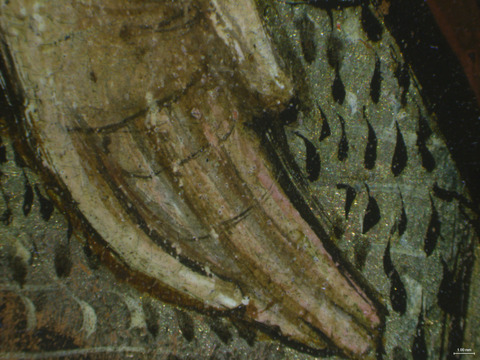
Pilate Washing His Hands (panel D):
Significant retouching is present throughout. Previous losses located in the Christ figure’s halo were subsequently retouched. Losses are present in gilded areas, some of which are restored with a shell gold paint.
Christ at the Column (panel E):
Areas of gilding were restored with a shell gold paint, although some original gilding remains visible in the halo and the top of the archways. A circular cracking pattern is visible on the man’s proper left foot, indicative of structural defects such as a knot in the wood. Abrasion is present in the faces, and this was later retouched. Shell gold was used to repair losses in gilding.
Mocking of Christ (panel F):
Restoration with shell gold paint is present in most of the gilding. Discolored retouching is present in the red canopy area. Losses along the left green border near the bottom-left corner reveal the white ground layer. Loss along left edge at 3 cm from the bottom-left corner reveals the white ground layer (possibly a fill). Losses of paint are found along all edges, later retouched.
Christ Carrying the Cross (panel G):
A large area of loss is present in the gilding and was previously restored in a heavy-handed manner. Scratches and losses are present throughout the gilding, revealing a black underlayer (see tech. fig. 28). Shell gold restoration is present in the top right. A significant amount of retouching is present across the panel.
Christ Nailed to the Cross (panel H):
Shell gold restoration is present along the top and side of the gilding. A large, circular crack is present by the white-robed hammering figure and is related to the structure of the panel (possibly a knot or defect in the wood). Discolored retouching is visible by the hammering figure’s foot at the bottom-center of panel.
Crucifixion (panel I):
Most of the gilding has been covered by shell gold paint, presumably due to losses. Discolored retouching is visible in areas of cracking and in the silver of the soldiers' armor. Engrained dirt is visible in the white cloth of Jesus. A scratch is present in the upper area of the panel that extends to the panel positioned above Christ at the Column (panel E), indicating the scratch happened when the panels were together, either before being cut apart or once they were reassembled in their proper configuration.
Descent from the Cross (panel J):
Significant losses are present in the gilding. These losses have been restored with shell gold. Abrasion can be seen in the black paint of the inscription above the cross, likely from over-cleaning. Some scratches in the gilding are related to the composition planning where incised lines were used to outline the figures.
Entombment (panel K):
There are significant losses on the gilding, later restored with shell gold paint, especially visible along the top border.
Resurrection (panel L):
Significant restoration is present in the gilding, executed with shell gold, particularly around the Christ figure and along the left edge. Losses exist in the top of the staff (1 × 0.2 cm) exposing the white ground underneath.
Description of Varnish/Surface Coating
Analyzed Observed Documented
| Type of Varnish | Application |
|---|---|
| Natural resin | Spray applied |
| Synthetic resin/other | Brush applied |
| Multiple Layers observed | Undetermined |
| No coating detected |
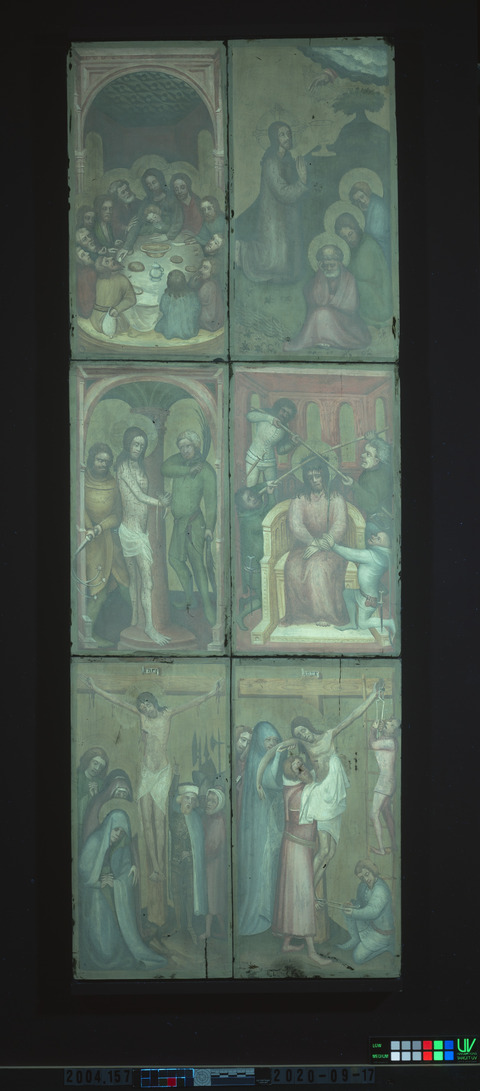
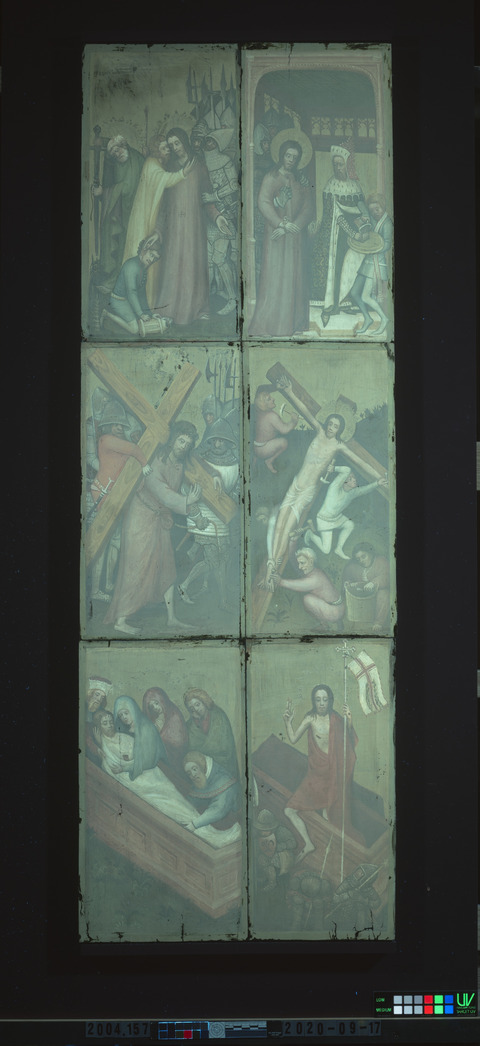
The panels have several layers of varnish (tech. figs. 44, 45). Both a natural resin varnish and a synthetic varnish are present over the surface of all 12 panels. Paraloid B-72 was sprayed on all panels in the conservation campaign of November 2006. Paraloid B-82 was applied in 1963 by conservator Louis Pomerantz to panels 1, 3, and 10. The natural resin varnish was not removed prior to the application of these varnishes and is therefore still present on all panels. When viewed under ultraviolet-induced visible fluorescence, the aged natural resin varnish fluoresces green and obscures a significant amount of the old retouching. Selective cleaning may have occurred in some panels in areas of gilding, such as Kiss of Judas (panel C) (tech. fig. 46), where the varnish in the upper left appears to be thinned. The background has also been regilded with gold leaf in several of the panels, and in other areas with gold paint such as shell gold.
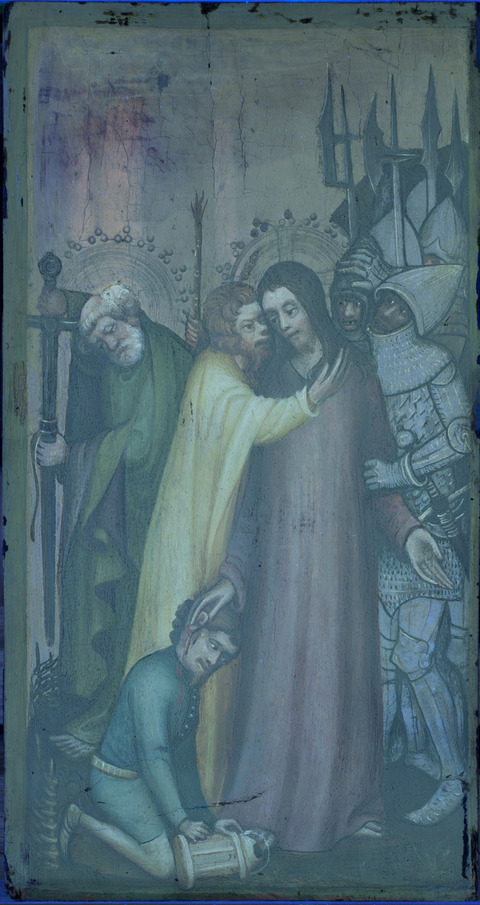
Condition of Varnish/Surface Coating
More recent inpainting campaigns can be easily identified as dark purple when viewed under ultraviolet-induced visible fluorescence; however, older retouching campaigns remain hidden beneath the aged natural resin varnish. Some of the retouching has discolored over time and no longer matches the surrounding original paint applied by the artist. Additionally, it is difficult to determine at times what is original, as many of the panels have been highly restored. Selective cleaning appears to have taken place, as some of the natural resin varnish is thinned. This is evident in a number of areas including some of the gold background. The varnish adequately saturates the painting and is a medium-level gloss. Some minor abrasions and matte areas are present throughout.
Description of Frame
Original/first frame
Period frame
Authenticity cannot be determined at this time/ further art historical research necessary
Reproduction frame (fabricated in the style of)
Replica frame (copy of an existing period frame)
Modern frame
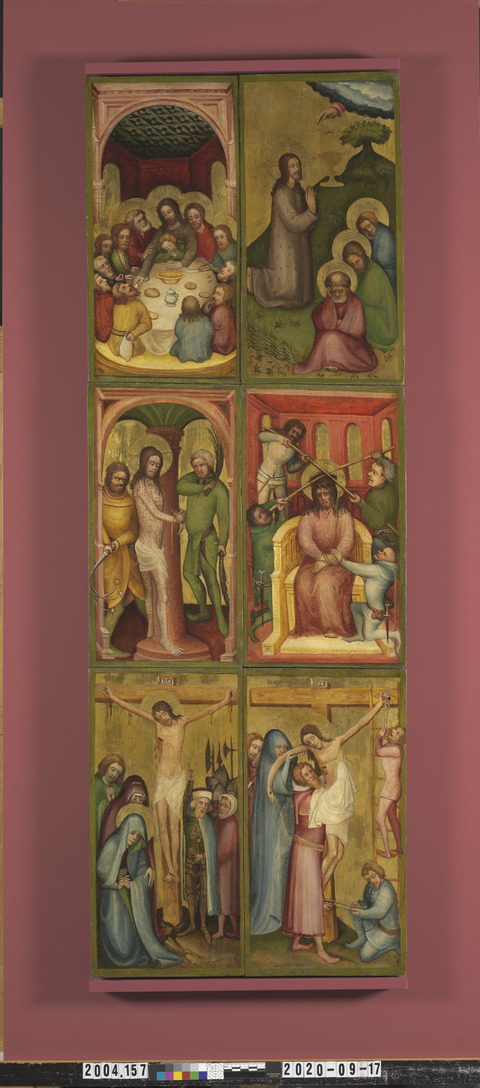
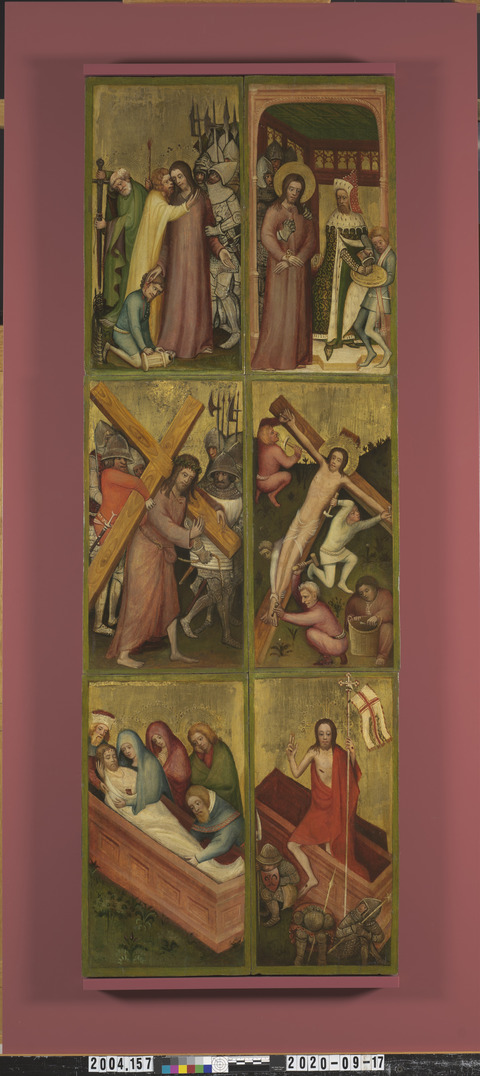
The paintings are mounted on a painted Masonite board in the orientation determined to be the original arrangement (tech. figs. 47, 48).
Frame Dimensions:
Mount dimensions: 129.5 × 58.4 cm
Distinguishing Marks:
None
Description of Molding/Profile:
N/A
Condition of Frame
The mounts are in good condition.
Notes
-
Documentation on file at the Indianapolis Museum of Art at Newfields. Three reports are on file from conservator Louis Pomerantz from February 1963 indicating conservation of the Kiss of Judas panel, the Descent from the Cross panel, and The Last Supper panel. ↩︎
-
Paul A.J. Spheeris, “Conservation Report on the Condition of the Clowes Collection,” 25 October 1971, Conservation Department Files, Indianapolis Museum of Art at Newfields. ↩︎
-
The sample appears to have been taken from panel F, The Mocking of Christ, although this cannot be confirmed with certainty. Email correspondence suggests a second sample was analyzed as well. It is unclear which panel that sample was taken from. Email correspondence between Peter Klein, Ágota Varga, and David Miller, 1 December 2011. ↩︎
-
Email correspondence between Peter Klein, Ágota Varga, and David Miller, 1 December 2011. ↩︎
-
Email correspondence between Peter Klein, Ágota Varga, and David Miller, 1 December 2011. ↩︎
-
Unless otherwise noted, left and right are given relative to the front of the panel. ↩︎
Additional Images



